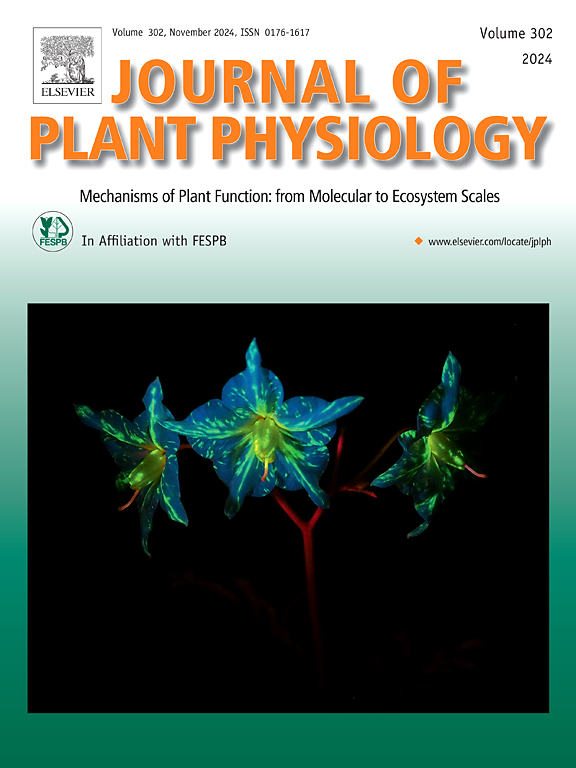能量水平对汤普森无核葡萄遮荫干燥过程中活性氧代谢的影响及其与褐变的关系。
IF 4
3区 生物学
Q1 PLANT SCIENCES
引用次数: 0
摘要
汤普森无籽葡萄在遮荫干燥过程中褐变严重阻碍了产业的持续健康发展。本研究研究了汤普森无籽葡萄经三磷酸腺苷(ATP)、2,4-二硝基酚(DNP)和水(QS)处理后在阴凉处干燥的褐变现象和活性氧(ROS)动态。通过生理、生化和蛋白质组学分析分析这些处理对活性氧代谢的影响。研究结果表明,与QS和DNP处理相比,ATP处理显著延缓了褐变和活性氧含量的增加,保持了活性氧清除酶(超氧化物歧化酶和过氧化物酶)的高活性水平,减少了丙二醛(一种膜脂过氧化产物)的产生,并保持了细胞膜的完整性。蛋白质组学分析确定了汤普森无籽葡萄中涉及ROS代谢的三个生物学途径:谷胱甘肽代谢、抗坏血酸和乙草酸代谢以及过氧化物酶体途径。外源ATP处理上调了17种蛋白(SOD、APX、GPX、GST、GR)的表达,其中GST2 (D7SKQ2)、POD1 (F6H095)、SOD3 (D7TI74)和SOD4 (F6HTX9)的表达量分别显著增加了1.707倍、1.589倍、1.644倍和2.213倍。因此,ATP处理维持了活性氧清除蛋白的表达,减少了活性氧的积累,维持了活性氧代谢的平衡,维持了细胞膜的稳定,抑制了脂质氧化,从而延缓了汤普森无籽葡萄的褐变。这些发现对汤普森无核葡萄遮荫干燥过程中褐变的调控具有重要意义。本文章由计算机程序翻译,如有差异,请以英文原文为准。
Effect of energy level on reactive oxygen species metabolism during shade-drying of Thompson seedless grapes and its relation to browning
The browning of Thompson seedless grapes during shade-drying significantly hampers the sustainable and healthy development of the industry. This study investigates the browning phenomenon and reactive oxygen species (ROS) dynamics when Thompson seedless grapes, treated with adenosine triphosphate (ATP), 2,4-dinitrophenol (DNP), and water (QS), are dried in the shade. The effects of these treatments on ROS metabolism were analyzed through physiological, biochemical, and proteomic analyses. The findings showed that ATP treatment markedly delayed the increase in browning and reactive oxygen content, maintained high activity levels of ROS scavenging enzymes (superoxide dismutase and peroxidase), reduced malondialdehyde production—a membrane lipid peroxidation product—and preserved cell membrane integrity compared to QS and DNP treatments. Proteomic analysis identified three biological pathways involved in ROS metabolism in Thompson seedless grapes: glutathione metabolism, ascorbic acid, and glyoxalate metabolism, and peroxisomal pathways. Exogenous ATP treatment upregulated the expression of 17 proteins (SOD, APX, GPX, GST, GR), with significant increases in GST2 (D7SKQ2), POD1 (F6H095), SOD3 (D7TI74), and SOD4 (F6HTX9) by 1.707, 1.589, 1.644, and 2.213-fold, respectively. Therefore, ATP treatment maintains ROS scavenging proteins’ expression, reduces the accumulation of ROS, maintains a balance in ROS metabolism, maintains the cell membrane stability and suppresses the oxidation of lipids, thus delaying the browning of Thompson seedless grapes. These findings are significant for regulating browning in the shade-drying process of Thompson seedless grapes.
求助全文
通过发布文献求助,成功后即可免费获取论文全文。
去求助
来源期刊

Journal of plant physiology
生物-植物科学
CiteScore
7.20
自引率
4.70%
发文量
196
审稿时长
32 days
期刊介绍:
The Journal of Plant Physiology is a broad-spectrum journal that welcomes high-quality submissions in all major areas of plant physiology, including plant biochemistry, functional biotechnology, computational and synthetic plant biology, growth and development, photosynthesis and respiration, transport and translocation, plant-microbe interactions, biotic and abiotic stress. Studies are welcome at all levels of integration ranging from molecules and cells to organisms and their environments and are expected to use state-of-the-art methodologies. Pure gene expression studies are not within the focus of our journal. To be considered for publication, papers must significantly contribute to the mechanistic understanding of physiological processes, and not be merely descriptive, or confirmatory of previous results. We encourage the submission of papers that explore the physiology of non-model as well as accepted model species and those that bridge basic and applied research. For instance, studies on agricultural plants that show new physiological mechanisms to improve agricultural efficiency are welcome. Studies performed under uncontrolled situations (e.g. field conditions) not providing mechanistic insight will not be considered for publication.
The Journal of Plant Physiology publishes several types of articles: Original Research Articles, Reviews, Perspectives Articles, and Short Communications. Reviews and Perspectives will be solicited by the Editors; unsolicited reviews are also welcome but only from authors with a strong track record in the field of the review. Original research papers comprise the majority of published contributions.
 求助内容:
求助内容: 应助结果提醒方式:
应助结果提醒方式:


